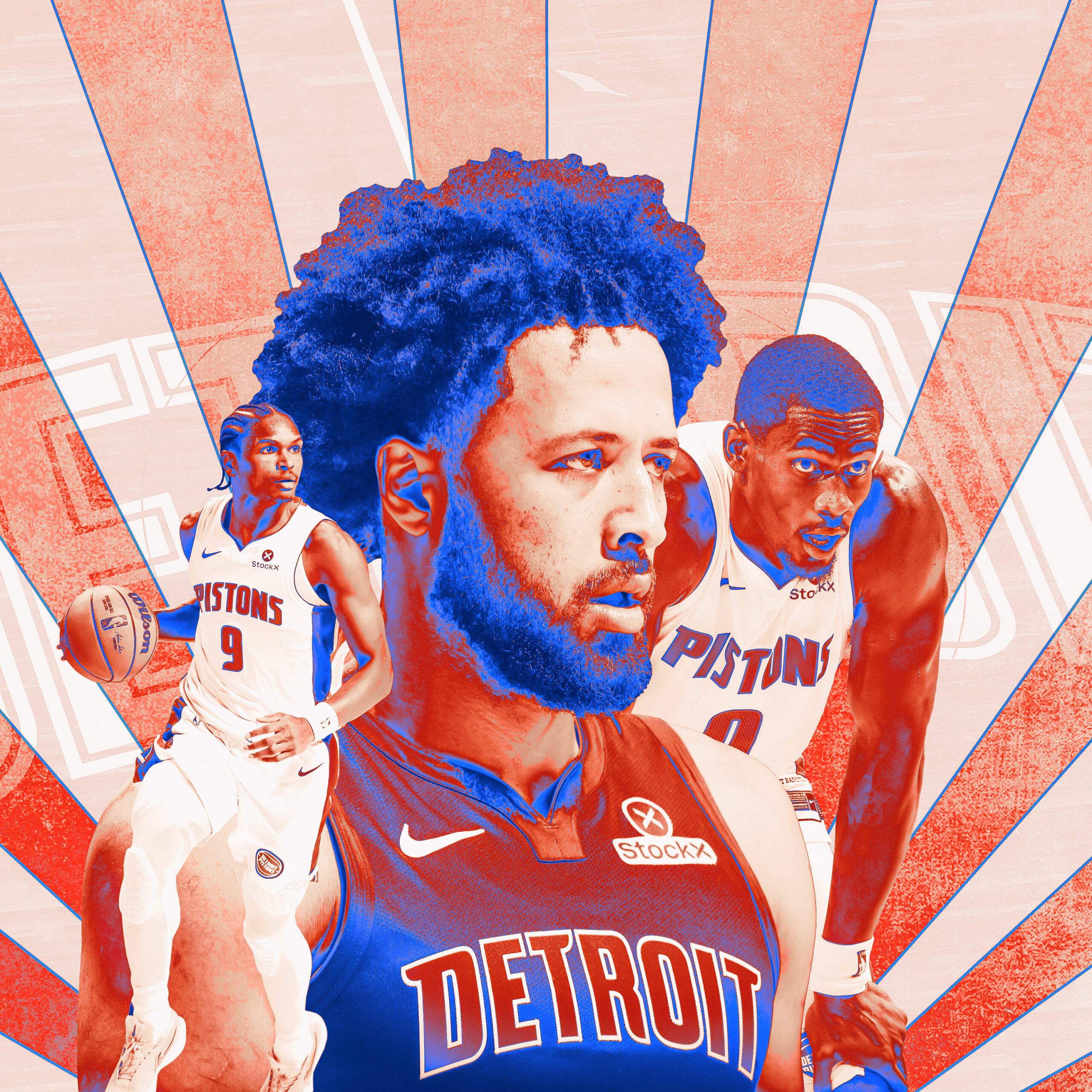
Cade Cunningham sat on the sideline at Little Caesars Arena on Wednesday night in street clothes, his thin wire-rimmed glasses and hooded leather jacket serving as a civilian guise for the hero he’s become in Detroit—a Motown Miles Morales. The Pistons were effectively icing the arm of their QB1. The team had just played three games in four nights, including a back-to-back set against the Sixers and Wizards that saw Cunningham log 72 points on 65 field goal attempts in 86 minutes, winning by a total margin of five points.
Wednesday’s game against the Bulls was supposed to be a write-off. Detroit’s entire optimal starting lineup sat out, and then some. No Cade. No Jalen Duren. No Ausar Thompson. No Isaiah Stewart. No Tobias Harris. No Jaden Ivey. No Marcus Sasser. Instead, there was Paul Reed, Ron Holland, Duncan Robinson, and a procession of the most Mandalorian-ass names imaginable: Daniss. Caris. Chaz. Tolu. Bobi. But from Detroit’s very first possession—a decisive Robinson pull-up 3 out of a dribble handoff with Reed—it was clear that the other guys were intent on running the Bulls off the floor. And they did, in arguably the most surprising win of the Pistons’ season since … their win against the Wizards on Monday, which necessitated some fourth-quarter heroics from both Cade and Daniss Jenkins (who just might be the Tracy McGrady of Sundiata Gaineses).
It’s been a long, long time since the Pistons have had this kind of rhythm, this kind of harmony up and down the roster. But here we are. Detroit is the hottest team in the league, winner of eight in a row, and atop the Eastern Conference standings at 10-2, its best start in two decades. It took the Pistons 62 games to get to 10 wins just two seasons ago. But these Pistons keep finding ways to win, two years removed from finding every conceivable way to lose.
There might not be a young star in the league who understands the fine line between winning and losing quite like Cunningham, who has plumbed the depths of basketball hell and emerged all the better for it. For anyone who has traced Detroit’s arc over the past few seasons, Cunningham’s performance in the team’s win over the Wizards on Monday night might best be seen as a spiritual redemption. There was a sort of symmetry at play with a game played the night after Christmas, two years ago, in arguably the bleakest loss in franchise history. On that night, Cade had the most efficient game of his career to date—41 points on a 78.6 effective field goal percentage—only to lose the game and officially saddle the 2023-24 Pistons with the longest single-season losing streak in NBA history. Back then, his best wasn’t good enough to dodge history; these days, even a historical off night carries with it a level of enchantment.
The Pistons won on Monday on the back of Cunningham’s 46-point triple-double. That’s a perfectly sensible headline! But depending on your vantage, it gets better or worse upon closer inspection. Cunningham’s 31 misses on Monday felt like a statistical hallucination in the year 2025. Of all the single-player performances in NBA history with at least 45 field goal attempts, Cunningham’s had the lowest field goal percentage in the modern era. Only (you guessed it) Jumpin’ Joe Fulks, the NBA’s first scoring champion in the mid-to-late 1940s, had games with a worse percentage on that much volume. It was the kind of brutal ends-justify-the-means performance that turned Kobe Bryant into one of the defining myths of the past quarter century. Since the 3-point line was instituted in 1979-80, there have been only eight instances of a player attempting that many shots in a game—and only Kobe and Cade have won shooting that much. In that sense, Cunningham’s deep and utter inefficiency against the Wizards was soulful. He bricked enough shots to break from the Matrix. Even one of the forefathers of advanced basketball analytics couldn’t discredit the positive impact of Cunningham’s performance. Those hard-earned 46 points were a transmission from a new reality. One that Pistons fans are still getting used to.
During the Pistons’ current winning streak, Detroit has scored 119.9 points per 100 possessions, a rate that would’ve graded the offense as the second best in the league last season. It’d be impossible not to credit Cunningham’s ongoing ascent. After a rather listless first four games, Cade has come alive in his seven most recent outings. Volume is up to career-high levels across the board. He had vocally made it an offseason goal to get better at shooting pull-up 3s, and while his overall percentages from behind the arc are disappointing, Cade has indeed been most comfortable this season shooting deep off the dribble. Nearly half of Cunningham’s 3-point attempts have come as the ball handler in a pick-and-roll, and he’s shot 40 percent on those attempts, according to Synergy Sports data. Nearly two-thirds of Cunningham’s 3s were assisted in his first four seasons; this season, two-thirds of his 3s have been self-created.
The ability to pull up from deep is practically a modern building block of perimeter stardom—Cunningham has made it a point of emphasis in his game the same way stars like Anthony Edwards and Shai Gilgeous-Alexander have over the past two seasons. The confidence Cade has exuded as a pull-up shooter has also opened up driving lanes unlike ever before—Cunningham is behind only SGA in total drives this season. His free throw attempt rate has spiked. And continuing a trend from last year, he isn’t afraid to punch the ball through the hoop when given a lane. He’s had nearly as many dunks in the past 81 games (44) as in his first 138 games combined (45).
The stars are aligning in Detroit, and no superstar pick-and-roll maestro is complete without an ideal recipient. Duren has answered the call amid a true breakout season. The 21-year-old has been the most effective roll man in the league this season, coupling volume and efficiency: Duren is scoring an absurd 1.46 points per possession out of the pick-and-roll (higher than even Nikola Jokic), converting 81.5 percent of his field goals attempted out of the play. He’s always boasted a chiseled frame and jet-pack explosiveness, but the instincts and vision he’s flashed as a passer over the years have always hinted at untapped potential. It’s being realized in year four, with Duren averaging 19.4 points and 12 rebounds per game. Health permitting, he’ll be a surefire finalist for Most Improved Player of the Year. The Pistons have put the ball in Duren’s hands more frequently this year, ramping up his usage. Defenders who had grown accustomed to Duren as a diving lob threat and a dribble handoff station out on the perimeter have had to quickly adjust to him starting to take bigs off the dribble from the top of the arc, à la Amar’e Stoudemire in the mid-aughts:
It’s been a long time since the Pistons have looked this good. And the last time they were this good, a 109.3 offensive rating was considered a top-five offense—Detroit’s current offensive efficiency would have seemed downright extraterrestrial back in the Ben Wallace days. But even in those dire intervening years, the fan base had gotten used to a baseline of playmaking chops from its big men. Greg Monroe found cutters from the left elbow. Blake Griffin had his little shovel pocket pass in a 4-5 pick-and-roll. Andre Drummond used to lord over a Pistons offense built almost entirely out of dribble handoffs near the top of the arc. Duren carries that lineage into these boom times. His assist numbers won’t blow anyone away, but the team clearly trusts him to make decisions with the ball in his hands on drives and out of the short roll. Teams are plenty aware of how dangerous he is as a finisher, and that leads to a lot of low-man help sinking back into the paint. Duren has grown adept at kicking the ball back out to the corners when the defense over-indexes:
There is a synergy building in Detroit that is finally paying dividends. Ever since drafting Cunningham in 2021, the Pistons have been dead set on surrounding their star tortoise with a bunch of hares through the draft lottery: Ivey and Duren in 2022, Thompson in 2023, Holland in 2024. Cade’s rare blend of size, craft, and processing power becomes a supercharged conduit for the irrepressible athleticism around him. The early yields were bleak, but now they’re humming.
Nowhere does Detroit’s physical advantage over most teams in the league show up more than on defense—a nod to those old Pistons whose footsteps this team now follows. The Thunder may be in a league of their own as a chaos engine, but the Pistons have found their own brilliant recipe for success, with the third-best defensive rating in the league. At the point of attack is Thompson, whose rabid aggression is the not-so-secret ingredient to turning his all-world athletic gifts into something incendiary. Flanking him is Holland, an athletic marvel in his own right, who plays with such raw nerve that you can almost see a static field around him. Detroit’s two hellhounds have become something of a Terror Twins East, flying around for contests, swiping and clawing for deflections, and falcon diving for blocks on the weak side. The Pistons’ rim protection—buttressed by the double-big lineup of Duren and Stewart, who cordon off the paint—is rather egalitarian, trusting in the effort and responsiveness of the help. And that even goes for their heliocentric star. Arguably the most impressive sequence in Cunningham’s magnificently inefficient performance on Monday came on defense. Immediately after scoring five straight points late in the fourth quarter to keep the Pistons within range, Cade made an absolutely textbook block as the low-man helper:
There is a sense of commitment to the cause across the entire team, evidenced by Detroit’s last two wins, which were largely indebted to the effort of reserves like Paul Reed and Daniss Jenkins. It’s a cohesion that can be fostered only by the identity driven by head coach J.B. Bickerstaff and by Cunningham, a captain who, even at 24 years of age, has seen some shit in this league. And there’s a sense that there is still plenty left on the table. The team has yet to play at full strength, and given how wide open the East is, the Pistons could be among the top buyers before the deadline. What might full strength even look like in a few months’ time? If Ivey is indeed still in the team’s long-term plans, can he be a reliable ball handler in the non-Cade minutes upon his return? Wednesday’s win over the Bulls with a motley-crew rotation seemed to home in on Duncan Robinson’s 3-point gravity—with the Pistons down near the very bottom of the league in 3-point attempt rate, is there enough leverage there to pump up the volume?
Two years after enduring a 28-game losing streak, Detroit has made itself a target in the East. Cunningham, who has had bouts of inefficiency his entire career, is about to face invigorated defenses that will be looking both to test the limits of his self-creation and to take the ball out of his hands entirely, forcing the rest of the team to beat them. Can he hold up against that pressure?
These are questions for another day. Yes, it’s still early in the season, but the vision is clear and is given focus by last year’s surprise ascent. After their win on Wednesday night, postgame analyst Grant Long couldn’t contain his excitement on the Pistons broadcast—he may or may not have predicted a 72-10 season for the team. It was hard to catch what he was implying through all the hitched laughter. “You have to celebrate these moments,” Long said. It was exultation, it was an in memoriam. Detroit basketball was in hell. And now it’s back.




